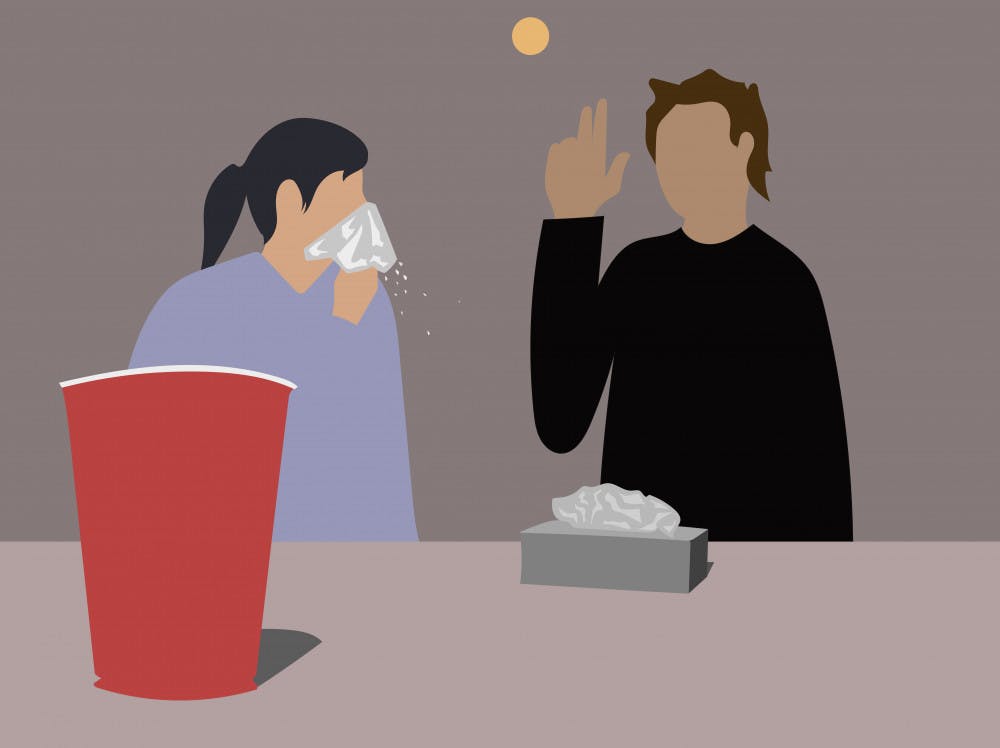As students take off their masks, an unwelcome hallmark of pre-pandemic life on campus has made its return: non-COVID-19 illnesses sweeping across College Hill.
The viruses infecting first-years and other students living on or near campus have proliferated to the point of near-ubiquity, students say. Medical experts at the University say that while the timing is abnormal, the outbreak itself isn’t unexpected, as pandemic restrictions loosen and students return to pre-pandemic levels of socialization.
Lily Lieber ’24 estimated that 90 percent of her close circle of friends has had some kind of illness — ranging from conjunctivitis to pneumonia.
“At one point, there wasn’t a (single) person on my 20-person floor who wasn’t sick,” Annika Sharp ’24 said.
Gidget Rosen ’24 echoed Sharp, saying that all of her friends had come down with an illness this summer.
First-years have come up with a number of nicknames for the illnesses: the “Keeney Cough,” “Keeney Cold” and “First-Year Cough” have all become synonymous with a sore throat, cough, congestion and a number of other symptoms that refuse to dissipate for weeks.
“It’s kind of a joke,” Lieber said. “Apparently, it didn’t even start (in Keeney).”
Caroline Sassan ’24 came down with what she called a “classic Keeney Cough.” It began with a sore throat, progressed into coughing and ended with “wanting to sleep” and her voice “pretty much gone,” she said.
“If I could’ve taken a sick day, it would’ve been over in a day or two,” Sassan noted, but her recovery has been stifled by midterms and schoolwork.
In the second week of the summer semester, Sharp also came down with a sore throat — the first time she had been sick since February last year. “I had kind of forgotten what it felt like to be sick,” she said.
The sore throat, which she thought she caught from a friend, turned into a cough that has not yet fully abated.
“You expect it to go away after a week,” she added. “Then two weeks hit, then three weeks hit.”
‘Lurking and waiting’: parainfluenza and other respiratory illnesses
The uptick in respiratory illness is expected, said Dr. Stefan Gravenstein, professor of medicine and director of the University’s division of geriatrics and palliative care. Masks and social distancing, he noted, did a good job of warding off COVID-19 infection — but also other viruses that cause respiratory illness such as the flu, parainfluenza and respiratory syncytial virus.
“We’ve had a respiratory infection holiday for almost a year. Everyone has had a break from being exposed — we’re especially susceptible as everybody starts getting together,” Gravenstein said. “It’s not having the constant push on the immune system to be ramped up and prepared. It’s this release of inhibitions because of all of the socialization — people want to get together and hug.”
Many of the students interviewed by The Herald reported having attended large parties and social gatherings, or having heard about them anecdotally. The concept of a pod has loosened as students interact with more people than they did last semester, they say.
The “Keeney Cough” that has spread as a result of these gatherings and other unmasked interactions seems to be parainfluenza in most cases, according to Dr. Adam Pallant, clinical director of Health Services and former pediatric residency director at the Warren Alpert Medical School.
Parainfluenzas, also known as “human parainfluenza viruses” has “no relation to influenza” — the “para” in its name roughly means “near or next to,” Pallant added. It typically pops up in the late fall, he said, but like other respiratory illnesses usually observed in colder weather, it has surged this summer in Rhode Island.
“These viruses have been lurking and waiting for their time,” Pallant said. “And now ‘bang,’ here they are. It’s not so surprising.”
The typical course of the parainfluenza virus starts with minor symptoms that get worse over four to five days, Pallant explained. The worst of it lasts for two or three days, before symptoms recede for the next four to five days.
“The typical malady is 10-14 days from start to finish, longer than other strains of colds,” he said. “You cough for ten days, up to three weeks if you’re not lucky.”
Often, parainfluenza symptoms include croup — a barking, spasmodic cough that sounds like a “dog or a seal” and can eventually lead to hoarseness or laryngitis. The virus also knows how to “tell the time,” Pallant said. Those infected will often wake up, start coughing, then feel better by mid-day, before getting “smacked” by the evening and coughing into the night.
Parainfluenza, though, is not the only virus going around campus, nor was it the first to show up this summer. In all likelihood, a litany of viral and bacterial infections are circulating, Pallant said.
“People in general have this concept that there is this thing called the common cold,” he said. But “hundreds upon hundreds of organisms, strains (and) substrains can cause a host of cold-related symptoms.”
Different symptoms over the course of weeks, Pallant added, aren’t different manifestations of the same virus: Different symptoms mean a different cold germ each time.
Anecdotal reports of strep throat are also up, according to Joseph Safer-Bakal ’24. After he came down with a cough, his mother shared that she had heard that strep was “going around.” Though he was doubtful, his test ultimately came back positive.
Strep throat is a “messy diagnosis,” according to Pallant: Anywhere from one in 10 to one in five strep tests can come back as false positives if the bacteria has “colonized” someone’s throat but isn’t active.
Out of the first-years who spoke to The Herald, only Safer-Bakal reported testing positive for strep, but two others said they had friends who either contracted strep or who got tested for the bacterial infection.
Students hesitate to visit Health Services
When Safer-Bakal decided to get tested for strep, he skipped Health Services altogether out of fear of his symptoms leading him to being placed in quarantine housing, and instead chose to go to the CVS MinuteClinic more than a mile away on Hope Street.
Sharp also went to the MinuteClinic for treatment, citing a number of reasons — among them a story she had heard of someone with a similar cough “getting quarantined.” There, she was diagnosed with a sinus infection and bronchitis, along with a prescription that she believes is helping with her illness.
The University, according to Pallant, has not placed a student into isolation for COVID-19 in two weeks as of last Friday.
“We’re not going to throw people into isolation lightly and particularly if you’re fully vaccinated,” he said.
Other first-years said the hassle of telehealth and rumors that they might not get a helpful diagnosis or treatment kept them away from Health Services.
“It was normalized not to see Health Services at the beginning of the semester,” said Jacob Danegger ’24, who has been sick with a number of symptoms, including a cough and sore throat, off and on for weeks. “It’s a pain to do a video call … People have gotten used to not going.”
Rosen said some of her neighbors also skipped out on making the trip to Health Services.
“Nobody really went to get treated by a professional for a while or was scared to,” she said.
Sharp also said that friends who had symptoms that overlapped with COVID — such as a cough — were also unable to do an in-person visit at Health Services.
According to Pallant, a student’s ability to go in-person to health services, in this circumstance, is at the discretion of the practitioner to whom they’re assigned.
“There are nurses, clinicians, providers that have a different range of concern about the potential for COVID-19,” he said. Ultimately, each patient’s experience “will be different in terms of how much effort is spent on telehealth versus how much is ‘come in and see me.’”
The Centers for Disease Control and Prevention and the Rhode Island Department of Health, Pallant added, are continuing to advise health care offices to follow and even enhance COVID-19 precautions, making the situation more confusing as students mainly present with parainfluenza.
Getting the right diagnosis
Diagnoses and prescriptions for these illnesses are not uniformly distributed. A number of students reported that they or their friends had all gone to Health Services only to be diagnosed with an exacerbation of pre-existing conditions such as asthma or allergies, or a cold for which they couldn’t be treated.
“I did call Health Services at one point,” Danegger said. “They were like, ‘it’s your asthma.’”
“My friend had gone to Health Services twice in the preceding three weeks,” Sharp noted. “There was nothing they could do.”
This, Pallant said, is indicative of a greater difficulty Health Services faces. In catering to the individual needs of students, there is no uniform course of treatment or process. Sometimes, no diagnosis and no treatment is better than sending a patient out the door with a prescription that will not ultimately help them.
A patient may be frustrated not to receive a prescription on the spot following a visit, which Pallant says can sometimes do more harm than good. “Sometimes, not doing anything is the best thing to do,” he said. “It’s not because we’re trying to misdiagnose you or withhold something from you.”
Lieber said she didn’t receive a diagnosis from her many calls with Health Services, but didn’t particularly mind.
“I was calling them almost daily, asking ‘What do I do, why am I feeling like this?’ I thought they were really helpful,” she said.
Getting sick, she added, is part of college: “I was telling my parents, and they were like, ‘yep, (that’s) college.’ People kind of just want to have fun, which is fair.”
“It’s really nice to know (that) we can get sick and it’s not COVID-19,” Rosen said. “It feels more harmless, even though a lot of the symptoms are the same or even worse.”
The extent to which campuses can now stop the spread of viruses that once simply ran their course is a new consideration, given the success that masking and social distancing had in halting the transmission of respiratory illnesses other than COVID-19.
“Part of me does wish that we implemented a little bit of what COVID-19 taught us,” Lieber said, like “respecting other people’s health” and “self-isolating if you feel that you need to.”
“If you mask and social distance, you can prevent the spread of respiratory disease,” Pallant said. “Do we go as far as to say that if we have an outbreak of parainfluenza and ‘Keeney Cough’ in December … (that) everyone should mask up, sanitize and distance, or during flu season? I do think we’re going to have some challenging decisions and conversations about that going forward.”

Will Kubzansky was the 133rd editor-in-chief and president of the Brown Daily Herald. Previously, he served as a University News editor overseeing the admission & financial aid and staff & student labor beats. In his free time, he plays the guitar and soccer — both poorly.





